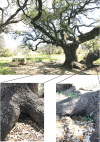Detection of Tickborne Relapsing Fever Spirochete, Austin, Texas, USA
- PMID: 30160650
- PMCID: PMC6199987
- DOI: 10.3201/eid2411.172033
Detection of Tickborne Relapsing Fever Spirochete, Austin, Texas, USA
Abstract
In March 2017, a patient became febrile within 4 days after visiting a rustic conference center in Austin, Texas, USA, where Austin Public Health suspected an outbreak of tickborne relapsing fever a month earlier. Evaluation of a patient blood smear and molecular diagnostic assays identified Borrelia turicatae as the causative agent. We could not gain access to the property to collect ticks. Thus, we focused efforts at a nearby public park, <1 mile from the suspected exposure site. We trapped Ornithodoros turicata ticks from 2 locations in the park, and laboratory evaluation resulted in cultivation of 3 B. turicatae isolates. Multilocus sequencing of 3 chromosomal loci (flaB, rrs, and gyrB) indicated that the isolates were identical to those of B. turicatae 91E135 (a tick isolate) and BTE5EL (a human isolate). We identified the endemicity of O. turicata ticks and likely emergence of B. turicatae in this city.
Keywords: Austin; Borrelia turicatae; Ornithodors turicata; Texas; United States; bacteria; borreliosis; diagnosis; elapsing fever spirochete; relapsing fever; spirochetes; tick-borne infections; ticks; vector-borne infections; zoonoses.
Figures




Similar articles
-
Diversity and distribution of the tick-borne relapsing fever spirochete Borrelia turicatae.PLoS Negl Trop Dis. 2021 Nov 23;15(11):e0009868. doi: 10.1371/journal.pntd.0009868. eCollection 2021 Nov. PLoS Negl Trop Dis. 2021. PMID: 34813588 Free PMC article.
-
Vector Competence of Geographical Populations of Ornithodoros turicata for the Tick-Borne Relapsing Fever Spirochete Borrelia turicatae.Appl Environ Microbiol. 2018 Oct 17;84(21):e01505-18. doi: 10.1128/AEM.01505-18. Print 2018 Nov 1. Appl Environ Microbiol. 2018. PMID: 30143510 Free PMC article.
-
An In Vitro Blood-Feeding Method Revealed Differential Borrelia turicatae (Spirochaetales: Spirochaetaceae) Gene Expression After Spirochete Acquisition and Colonization in the Soft Tick Ornithodoros turicata (Acari: Argasidae).J Med Entomol. 2017 Mar 1;54(2):441-449. doi: 10.1093/jme/tjw171. J Med Entomol. 2017. PMID: 28399292
-
Tick-borne relapsing fever.Infect Dis Clin North Am. 2008 Sep;22(3):449-68, viii. doi: 10.1016/j.idc.2008.03.006. Infect Dis Clin North Am. 2008. PMID: 18755384 Free PMC article. Review.
-
Relapsing fever borreliosis in Eurasia--forgotten, but certainly not gone!Clin Microbiol Infect. 2009 May;15(5):407-14. doi: 10.1111/j.1469-0691.2009.02767.x. Clin Microbiol Infect. 2009. PMID: 19489923 Review.
Cited by
-
Diversity and distribution of the tick-borne relapsing fever spirochete Borrelia turicatae.PLoS Negl Trop Dis. 2021 Nov 23;15(11):e0009868. doi: 10.1371/journal.pntd.0009868. eCollection 2021 Nov. PLoS Negl Trop Dis. 2021. PMID: 34813588 Free PMC article.
-
Isolation of Borrelia miyamotoi and other Borreliae using a modified BSK medium.Sci Rep. 2021 Jan 21;11(1):1926. doi: 10.1038/s41598-021-81252-1. Sci Rep. 2021. PMID: 33479281 Free PMC article.
-
Seroprevalence for the tick-borne relapsing fever spirochete Borrelia turicatae among small and medium sized mammals of Texas.PLoS Negl Trop Dis. 2018 Oct 29;12(10):e0006877. doi: 10.1371/journal.pntd.0006877. eCollection 2018 Oct. PLoS Negl Trop Dis. 2018. PMID: 30372445 Free PMC article.
-
Tick borne relapsing fever - a systematic review and analysis of the literature.PLoS Negl Trop Dis. 2022 Feb 16;16(2):e0010212. doi: 10.1371/journal.pntd.0010212. eCollection 2022 Feb. PLoS Negl Trop Dis. 2022. PMID: 35171908 Free PMC article.
-
Differential Expression of Putative Ornithodoros turicata Defensins Mediated by Tick Feeding.Front Cell Infect Microbiol. 2020 May 5;10:152. doi: 10.3389/fcimb.2020.00152. eCollection 2020. Front Cell Infect Microbiol. 2020. PMID: 32477960 Free PMC article.
References
Publication types
MeSH terms
Substances
LinkOut - more resources
Full Text Sources
Other Literature Sources
Molecular Biology Databases

